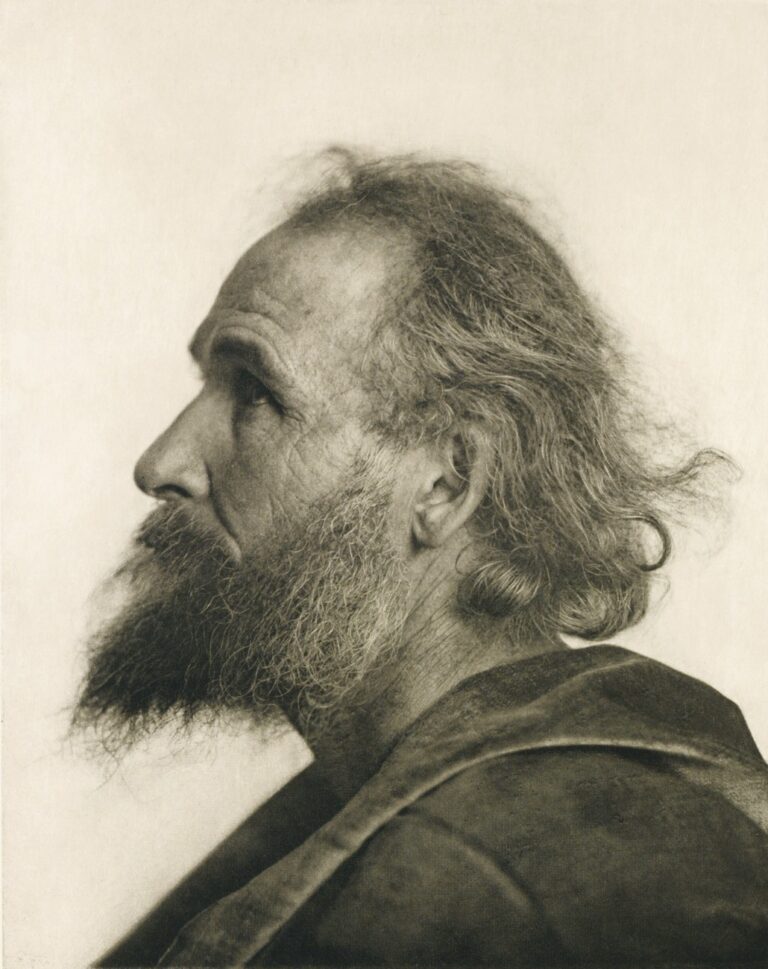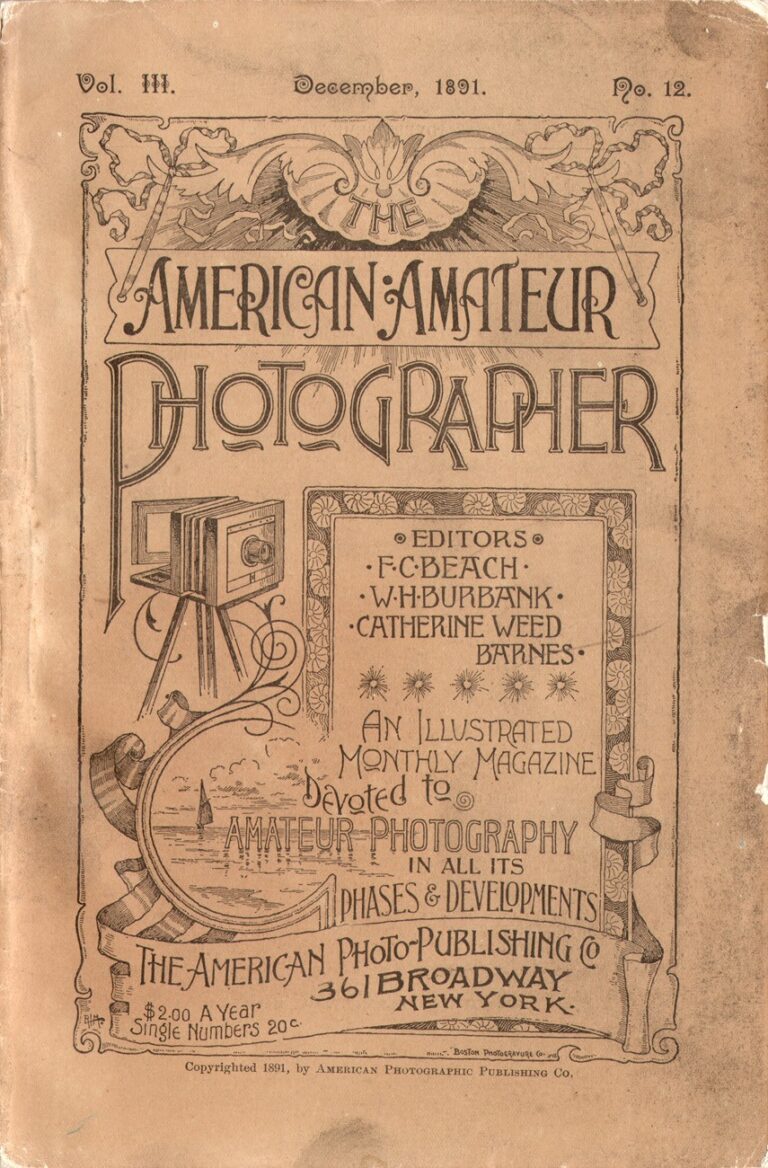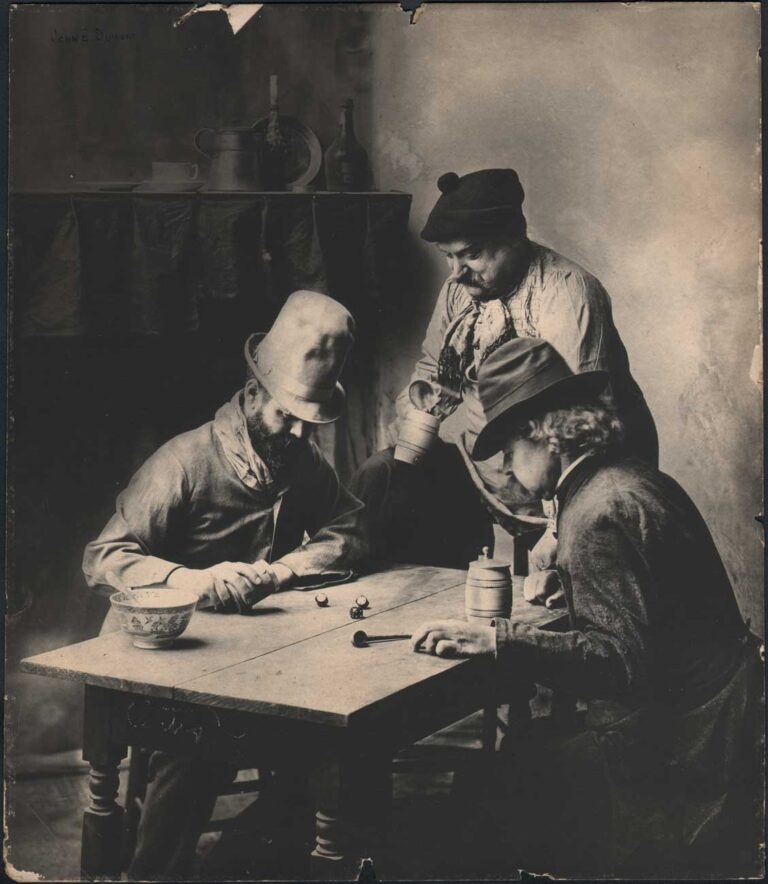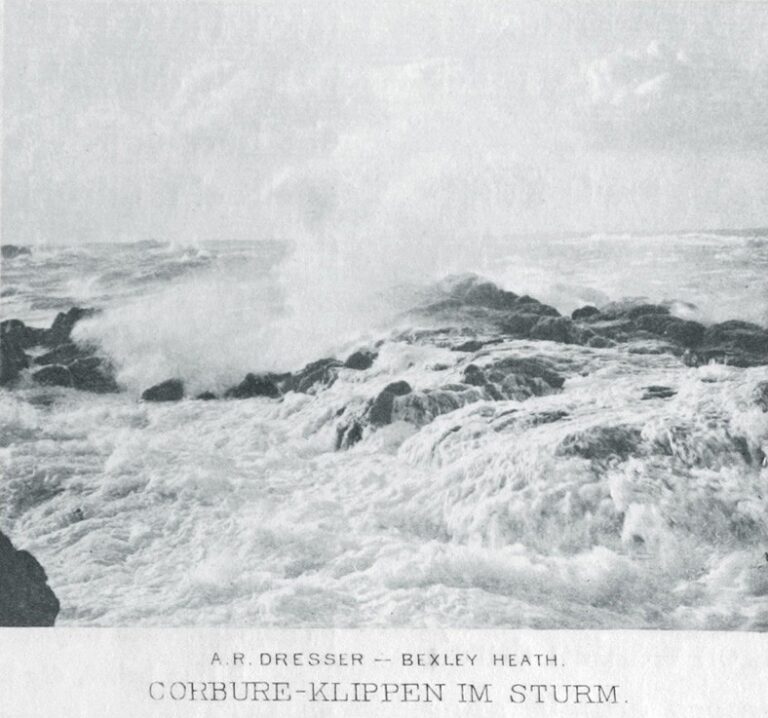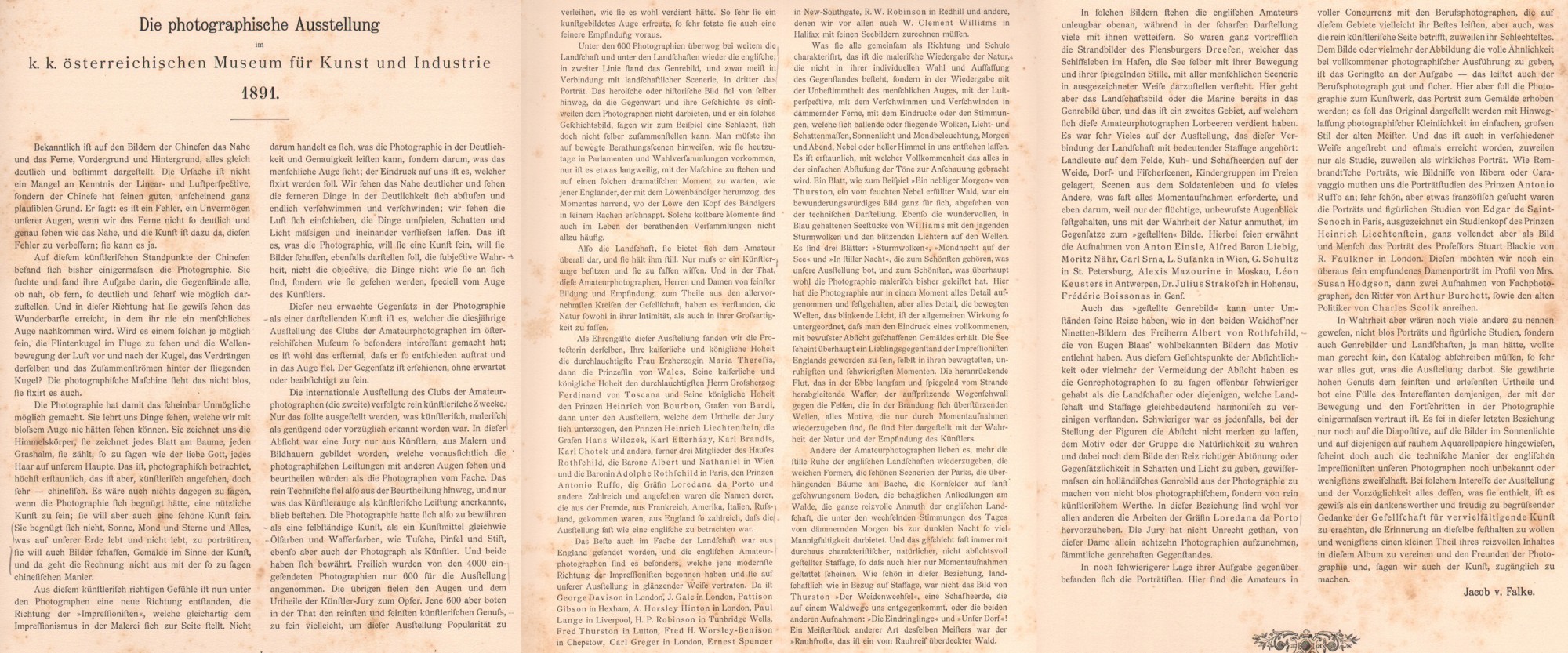
Künstlerischer Theil : Jacob von Falke
PhotoSeed wishes to thank Frauke Fischer for transcribing author Jacob von Falke’s original essay on his artistic observations of the 1891 Vienna exhibit from the Old German. Due to dialectical variances in the original, the complete essay is posted as part of our online exhibit for purposes of further scholarly investigative clarification. Please enlarge your browser in lightbox mode to magnify text.
Amateur-Kunst : Künstlerischer Theil : Jacob Ritter von Falke
“The well known Chinese ability to paint their pictures both close up & far away was so real to see for human eyes. That was the first step for a camera. For the first time you could identify the bullet flying and the movements of the waves from the beginning to the end. The photographic machine not only saw that motion it also brought it to a standstill. Photography accomplished herewith the impossible to reality. It taught us to see things a human eye never could comprehend. The photo showed us every leaf of the tree, every blade of grass, the stars of the universe. In other words, as if God counted every hair on our head. In all, it was pretty amazing from the artistic photographic aspect- it was really a Chinese way of creativity. One could say photography not only showed all the movement but also brought beauty into light. She wasn’t happy just to show the Sun, Moon and Stars and everything on Earth alive and dead, but in the way of art and at the end result it wasn’t quite the Chinese art.
Out of the artistic view of the photographer became the time of the Impressionist not only to be on the side of the painter, but also the photo to show the real and unreal story so the human eye can see and understand the expressions. We see the closeness close and the faraway fading away. We can see the air playing a role, the shadow and the light coming together. The photo brings everything to light, showing as it really is especially from the eyes of the artist.
This new theory of photography in an artistic way resulted in this year’s exciting show of amateur photographers clubs in Austria’s museum because of the interesting new way of presentation. The new way was just there without having it on their mind.
The 2nd International show was all about the artistic side. Only those were shown that seemed artistic, colorful and beautiful. Because of this a new jury of painters, artists and sculptors was born, for they admired the special ways of the photographers and did not judge the technical side but only the artistic side as the important one. Photography had to prove in itself as art like the painters use of paint, brush & pencil. Everything came together. Out of 4000 photographs only 600 were chosen for this exhibit which were pleasing to the artistic palette. Maybe this would give clear understanding to the photographic arts the popularity it needed. Though it gave pleasure to the artistic eye, the feeling side was brought into light. Of the 600 photographs mostly were sceneries and mostly English. The second part genre photos and the third were portraits. The historic and heroic pictures of this time could not be done by itself. To wait for the right moment to take a dramatic picture, like a meeting for government and voting was too time consuming. An Englishman, who toured with a lion tamer, was waiting patiently to take photos at the specific moment when the trainer put his head into the lion’s mouth. These precious moments needed help of guidance when to take an action shot.
Amateur photographers took pictures of nature scenery but only photographers, men and women alike, with an eye and feeling for photography understood to snap pictures of scenery in all its glory and intimacy.
Among the special guests at the art show we found perfectionism in itself, her Royal Majesty Maria Theresia, Princess of Wales, his Majesty Ferdinand Von Toscana, Prince Heinrich Von Bourbon and the Earl Von Bardi who were judged by the Prince Heinrich Lichtenstein, the Earls Hans Wilczek, Karl Esterhàzy, Karl Brandis, Karl Chotek and also three members of the house of Rothschild, the Barons Albert and Nathaniel from Vienna and the Baroness Adolphe Rothschild from Paris, the Prince Antonio Russo, the Baroness Loredana da Porto and more.
Many of the important people, not only in name, took part in the art show and came from far away like France, America, Italy, Russia, but the most were from England. You could call it the English show.
The best of the nature scenery was sent from England and the English amateur photographers, who began at the time of the impressionist were plentiful. There were George Davison, from London, J. Gale from London, Pattison Gibson from Hexham, A. Horsley Hinton from London, Paul Lange from Liverpool, H.P. Robinson from Tunbridge Wells, Fred Thurston from Lutton, Fred H. Worsley-Benison from Chepstow, Carl Greger from London, Ernest Spencer from New Southgate, R.W. Robinson from Redhill and many more. Especially goes recognition to W. Clement Williams from Halifax who took pictures of the sea world.
What all of them had in common of schooling and guidance was to paint real nature and beauty with the naked eyes to express the nearness and distance fading away, to create the moments of moving clouds, shadows, sunlight and moonlight, the difference of morning and evening, fog or clear sky for us to recognize. It is astonishing how clear the colors and mixing with others were transformed for us to see. For example a leaf or a foggy morning by Thurston, damp foggy woods- was a picture in itself, without the technical glimpse. Also the gorgeous blue tone painted seas from Williams with the fast fleeting storm clouds and the flickering lightenings on the waves. There are three paintings- Storm Clouds, Moonlight on the Sea and the Silent Night were the most beautiful paintings of the art show presented where the photography captured the brilliance of a painting for the first time. Photography took & showed the moment with every detail, the movement of the waves, the blinking lights so detailed that one thought you stood before a painting. The sea was most likely to become the hobby model of the English impressionists, even in their most wild and calmest moments. The incoming tide which is slowly moving and playfully reaches the bank, the waves of water hitting the rocks are here captured in the moment of taking the picture and the feeling of the artist.
Other amateur photographers love to transform the serenity of countryside into pictures. They love the scenery of parks with its trees hanging low over the water, the cornfields, the hills of the countryside, the quaint little villages by the forest and the lovely countryside in itself. The ever changing time of the day, from the beginning of the mornings to the darkened evenings and nights. The picture from Thurston “Der Weidenwechsel”, where a herd of sheep is coming toward us from a walkway out of the forest or the two other pictures: “Die Eindringlinge” and “Unser Dorf”. A masterpiece from another side from this same artist was “Rauhfrost”-a picture of a frost covered forest.
In those photos the English amateurs are tops, but many are competing against those where sharpness is progress. The beach pictures from Dreesen of Flensburg were excellent, he was bringing life into his harbor pictures, the sea with all the movements and stillness was fantastically portrayed. But here goes the nature scenery or marine already over into the genre picture, and in this second phase the amateur photographers received recognition and praise. One could find many things at the art show that brought out the significance of nature: farmers in the fields, cows and shepherds on the grasslands, small towns and fishing scenes, groups of children sitting together, scenes of soldiers and so many other things needed for the moment picture showing us the true countryside other than the opposite side of a posed one. Just to mention a few names of still photography are Anton Einsle, Alfred Baron Liebig, Moritz Nähr, Carl Srna, L. Susanka of Vienna, G. Schultz of St. Petersburg, Alexis Mazourine of Moscow, Léon Keusters of Antwerp, Dr. Julius Strakosch of Hohenau and Fréderic Boissonas of Switzerland.
The posed genre photo perhaps could have its charm like the two photos from Baron Albert Von Rothschild. Because of the posed photographs and the unwilling intrusion it was more difficult for the genre photographers or the ones where the countryside and posed side were brought harmoniously together. It was most difficult in posing the figures and not let the intension be known in the model or group in order to bring out the natural state and true beauty and the shadows & light combined. Therefore these were more like Dutch genre photos, not only from the photographic side but the real artistic side. Here the jury decided to take 18 photos from Countess Loredana da Porto for the viewing of the genre photographic side.
It was much more difficult for the portrait way. The amateurs here were rivals with the occupational photographers who showed their best of the best, also on the artistic side, the worst. The photography here was to become art, the portrait into a painting. It should describe the original without triviality in the plain and creative style of the masters. Many tried to reach this understanding and sometimes attained this knowledge, sometimes only as a study and also as a real portrait. Like Rembrandt portraits, the images from Ribera or Caravaggio let us think of portrait studies by Prince Antonio Ruffo. There was also some French influence in the portraits by Edgar de Saint-Senoch of Paris whose excellent bust of Prince Heinrich of Lichtenstein was perfection as a picture as well as a portrait of Professor Stuart Blackie by R. Faulkner of London. We also would like to mention a woman’s portrait in profile by Mrs. Susan Hodgson and two photos by special photographers: “A Knight” by Arthur Burchett and the “Old Politician” by Charles Scolik.
Truthfully we could mention many more, not only for their portraits and figures, but genre pictures and landscapes could we write about in the catalogue. Everything was very good shown at the art show. It gave a lot of pleasure to the people who were knowledgeable in the movements of photography. In the interest of this versatile art show and everything it portrayed it has been a delightful idea for the Friends of Photography to put together this album to remember it by.”
